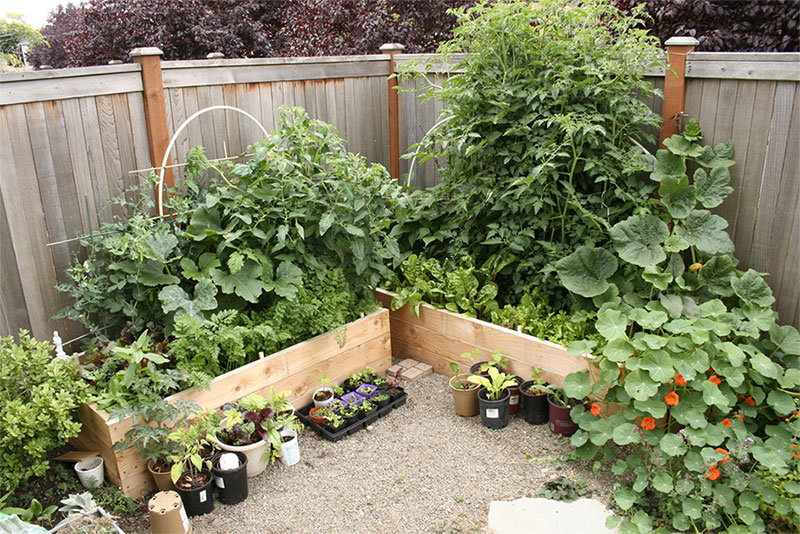Ready to start growing your own food and reaping the rewards while reducing your impact on the environment?
Here is a quick guide to get you started growing your own food at home!
Location & Space
You may or may not have a large backyard available to start growing your own food. Good news is you don’t necessarily need a lot of space to grow your own food! If you’re working with limited space you can grow in containers, make use of vertical space or even start a verge garden. See our run down on tips for growing in a limited space. Even if you do have an abundance of space you may want to start small.
Select a site which:
- receives ample and appropriate sun exposure – full sun in winter and protection from some of the harsh afternoon sun in summer is generally ideal for most crops.
- has protection from strong winds.
- is convenient to access for harvest and maintenance.
- if on a slope, allows for planting along contours to assist with rain capture and run off.
Climate
Generally crops are planted with the seasons and relation to climate, so you’ll need to consider your local climate and time of year when selecting your crops. See our overview of Australian climate zones and plant hardiness.
Beds & Borders
When determining the shape of your garden beds, keep in mind that you want to avoid walking on the soil. One way to solve this is to not make the beds too wide! Utilizing this method, you can easily access your plants without needing to trod on your soil or even other plants. If you can access the bed from a single side then aim for around a maximum width of around three quarters of a metre (2.5 feet) or double that if you can access it from both sides.
Inspiration may strike and you wish to add borders around your garden! It doesn’t need to be fancy! The border could be made with bricks, sleepers, stones, branches or similar materials you have lying around.

Garden Beds. Image sourced from TinyHaus – The Pleasure of Tiny Things
Soil
Food producing gardens require a high dose of organic matter and nutrients to in turn grow you delicious food. Unless you live in a hyper fertile region you’ll need to improve the soil. Add plenty of organic material to your garden beds. This includes: compost, worm castings, chicken and cow manure. If you’re just getting started, you might need to take a trip to your local nursery or hardware store to pick up some of these items for your garden.
You can also:
- Grow cover crops to suppress weeds and increase soil productivity.
- Physically break up heavy soils with a shovel or garden fork.
- Protect the soil with a layer of organic mulch.
Select Plants
Select what you want to grow based on your climate, season, available space and what you enjoy – not much point growing vegetables you despise! For advice, check out resources such as Gardenate or ask your local nurseries for assistance. Where possible stick with organic and heirloom varieties.
You can get seeds and plants from local nurseries or hardware stores but you might want to consider some of these top quality seed suppliers:
- The Diggers Club
- Green Harvest Organic Gardening Supplies
- EdenSeeds
- Greenpatch Organic Seeds
- Seed Savers
Furthermore, do some research on companion planting to boost harmony in your garden beds. Sign up for our newsletter and received our companion planting PDF!
Water
Your soil should feel moist at all times. In hot weather you might need to water your crops every day, while in winter you may not need to water at all. Watering is most efficiently done by using a drip line irrigation system underneath a layer of mulch. While using mains water to grow food is hardly a waste, you get bonus points if your irrigation system is fed from a rainwater tank.
Maintenance
On top of watering, your garden will require additional maintenance from time to time.
Removing weeds is important as they compete with your crops for sunlight, water, space and nutrients. Remove weeds mechanically by pulling them by hand or using a tiller/garden hoe rather than using herbicides. Mulching is also a good way of impede weed growth.
Diversity and companion planting help to create favorable conditions for your plants, often by repelling harmful pests or attracting beneficial ones. In the event your garden requires additional pest control intervention, avoid the use of synthetic chemical pesticides. If you really need to spray try organic home-made remedies which can often be made with common household items.
Harvest
Enjoy your harvest! Remember to do some research on when to harvest your crops. Different plants will ripen at different times and some may produce multiple crops throughout a season.
At the end of each growing season remember to revitalise soil nutrients by adding compost, manure and other organic matter. Crop rotation is also advised for many species to reduce the chance of disease taking hold of your crops.
Get Involved!
Be proud of the food you grow yourself.
Get involved and share your food growing efforts with us on social media via Instagram or Twitter using the #growityoself hashtag or directly on our Facebook page.
